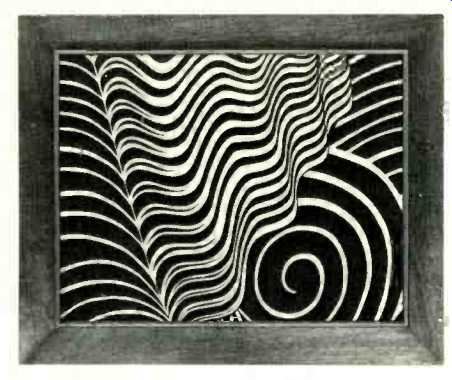
MANUFACTURER'S SPECIFICATIONS
Frequency response: 40 Hz-18,000 Hz.
Maximum music power: 50 watts.
Maximum rms power: 25 watts.
High frequency driver voice coil: 1 inch.
Low frequency driver voice coil: 1 inch.
Magnet structure: 2.64 lbs. Impedance: 8 ohms.
Weight: 21 lbs.
Dimensions: 29 3/4 by 23 3/4 by 2 1/8 inches deep.
Price: $138.
Loudspeakers with flat diaphragms are not new and we well remember a British unit called the Midgely-Harmer which appeared on the market around 1936. It used a dural diaphragm with the voice coil mounted off-center to reduce resonances. The diaphragm was very thin and it was protected by a heavy chromium plated grille which looked so elegant that many manufacturers mounted the unit with the grille on the outside of the cabinet. This was a mistake because people were so intrigued by the metal diaphragm that they poked at it through the grille with pencils and knitting needles-with disastrous results! The sound had a metallic coloration and, all-in-all the MH system was not a resounding success!
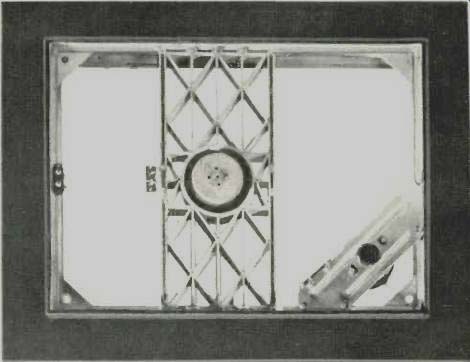
Fig. 1-Showing the two drivers.
Electrostatic systems use flat diaphragms--and then there is the Orthophase and the Audio Research Magnaplanar. But cones have many advantages for dynamic speakers in regard to rigidity, mass to strength ratio and so on. Expanded polystyrene seemed to be an ideal material for flat speaker diaphragms but it was soon discovered that this material had problems too. Internal friction was high and the transverse resonances caused severe irregularities in the response. Resin impregnation and aluminum skins helped to solve these problems and among the speakers using flat polystyrene diaphragms are those made by the British KEF. These units have a linear response up to 1 kHz and are used by a number of manufacturers here including Infinity, ESS and IMF. Another speaker using a flat plastic diaphragm is the Yamaha which, for some reason, is shaped like a human ear.
The diaphragm is clamped at the edges and vibrates rather than moves in a conventional manner. Recent developments in quadraphonic sound have inspired speaker designers to take another look at flat speakers which might help to overcome some domestic objections to 4 speakers in a room. If two at least could be made inconspicuous, fine; but if they could be disguised as pictures that could even add to the decor--better still. And so Fisher have brought out the PL 6 Sound Panels with a wide choice in artistic design-contemporary, abstract or representational. They can be hung on the wall, built into room dividers or stood on the floor. The back is partially open so the sound pattern is roughly dipolar (Omni-directional at some frequencies). Two dynamic drivers are used, one mounted off-center for bass, crossing over at 2 kHz to a HF unit which is located at one corner. The diaphragm is made of expanded polystyrene clamped at the edges so the system is highly efficient. This diaphragm has variable density and thickness but the secret, or shall we say piece de resistance of the PL 6 is the use of a non-linear compliance between the voice coils and diaphragm. It is made of a co-polymer in the form of a 1/4 inch disc, slightly larger than the voice coil and its function is to equalize the response. Figure 1 shows the rear view before the diaphragm is mounted; both voice coils are four-layer and the diaphragm area near the treble unit is treated to improve the HF response.
Measurements

Fig. 2--Response measured with one-third octave pink noise. 'A' was taken with
the speaker 3 inches from a wall and 'B' at 6 inches.
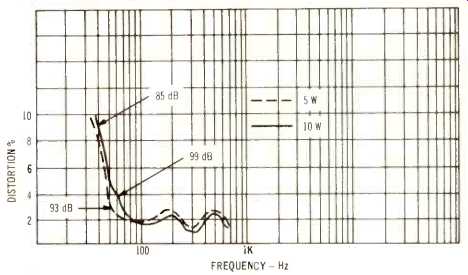
Fig. 3--Response measured with the speaker in the middle of a room. A on axis
B at 30 degrees and C at 60 degrees off-axis.
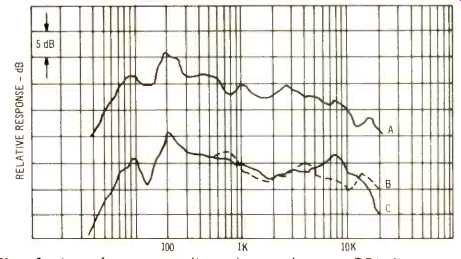
Fig. 4--Low frequency distortion and some SPL figures.
Figure 2 shows the frequency response taken with one-third octave pink noise. A was taken on-axis with the unit mounted 3 inches from a wall and B with the space increased to 6 inches. Figure 3 shows the response with the speakers in the middle of the room and 3A shows the radiation at 30 and 60 degrees off-axis. Low-frequency distortion and SPL measurements are given in the graphs at Figure 4 and the impedance curves are shown in Figure 5. It will be seen that the system resonance is just under 60 Hz. Tone-burst characteristics at 100 Hz, 500 Hz and 5 kHz are shown in Figure 6. White noise showed some mid-range coloration, not judged too serious.
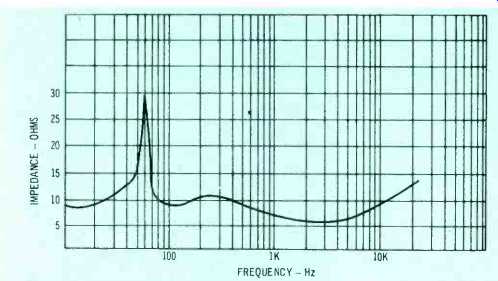
Fig. 5--Impedance characteristics

Fig. 6--Tone-burst characteristics at 100, 500, and 5000 Hz
Listening Tests
Having had considerable experience with thin, flat speakers over a long period, we were well aware of the difficulties.
For one thing, it is not easy to get a reasonable bass response due to the inevitable cancellation. True, a large radiating area helps but it would have to be very big indeed to produce a good output below 100 Hz. So we thought-but we were wrong. When we first heard the Sound Panels we knew about the flexible coupling but, well--we were somewhat skeptical. And so we were amazed at the healthy bass response-the coupling gadget really works! In fact, if the unit is placed in a corner, some people would find the bass too prominent. A useful output was obtained down to 38 Hz and the system would handle 62 watts at 40 Hz and 75 watts at 100 Hz without audible signs of distress. Instructions call for a spacing of at least 3 inches from a wall and under these conditions there was an appreciable loss of low frequencies (see Figure 7). This could be compensated for by judicious use of the tone controls. Better balance was obtained with the units standing on the floor (suitable feet are provided) although some treble lift might be desirable in some rooms.
Sensitivity was 3 to 5 dB higher than average so they could be used in a quadraphonic system or conversion, with a small amplifier for rear channels.
How does it compare with conventional systems in the same price class? Well, at low levels many listeners thought the PL 6's had a more open quality but at high power levels the cabinet systems were clearly superior. On the other hand, the Sound Panels do have considerable advantages and they only need 6 to 8 watts for quite large rooms.
-T.A., G.T. P.S.
You might ask, "How about those wires running up the wall?" Fisher have thought about that too and they can supply flat conductors that can be painted to make them "invisible".
(Audio magazine, Mar 1973)
Also see:
Fisher RS-Z1 Receiver (Aug. 1990)
Fisher ST-425 Speaker System (Equip. Profile, Jan. 1975)
= = = =